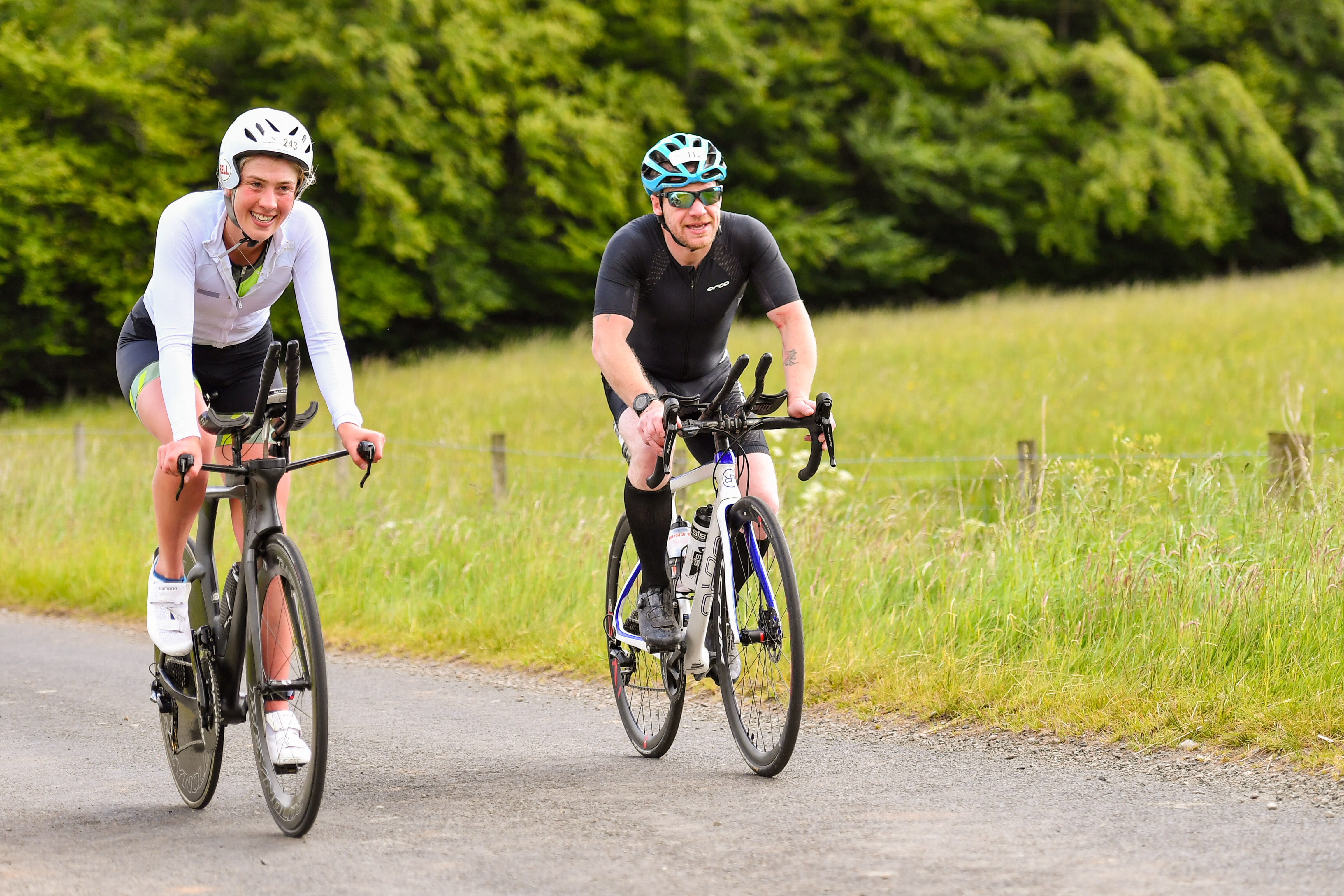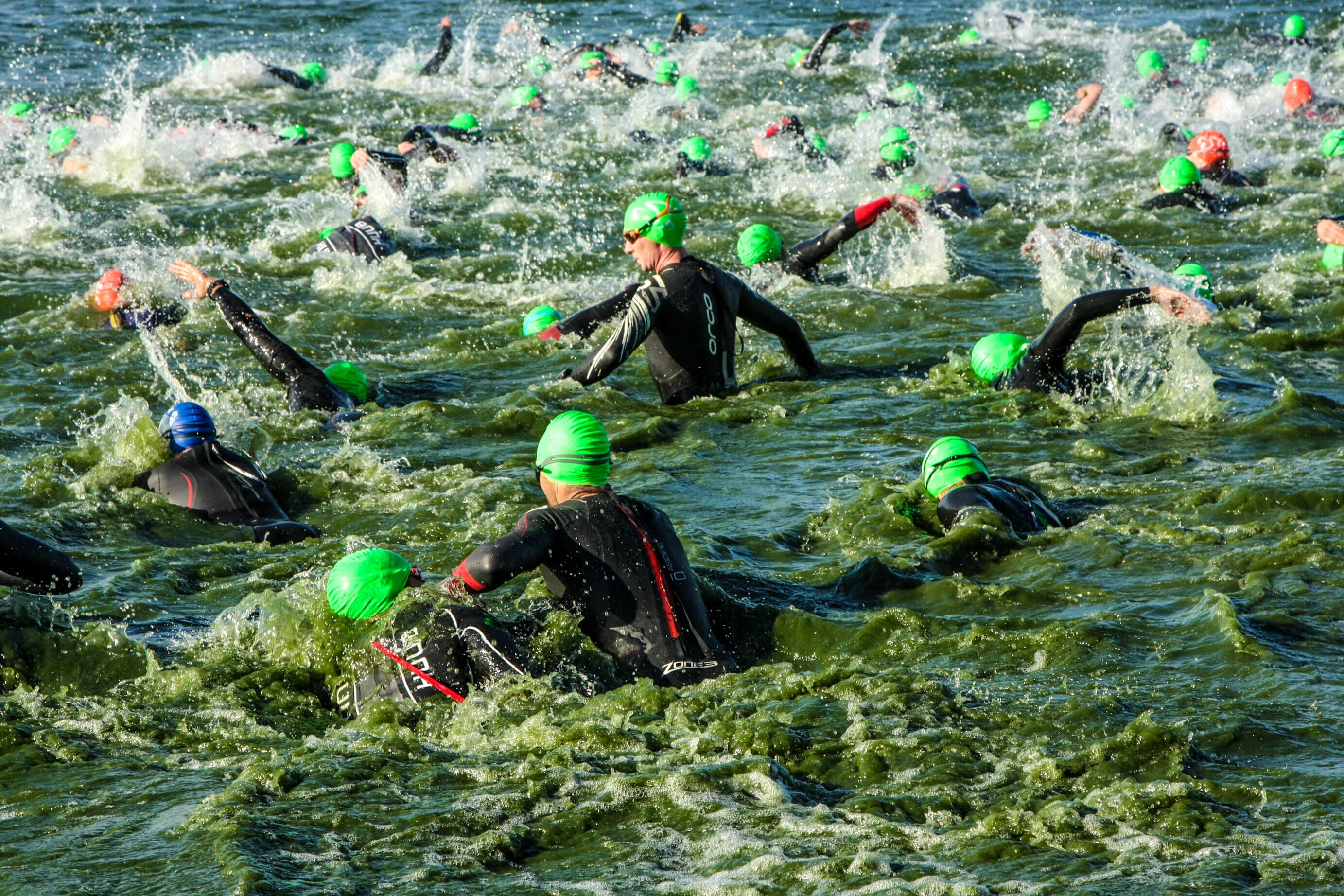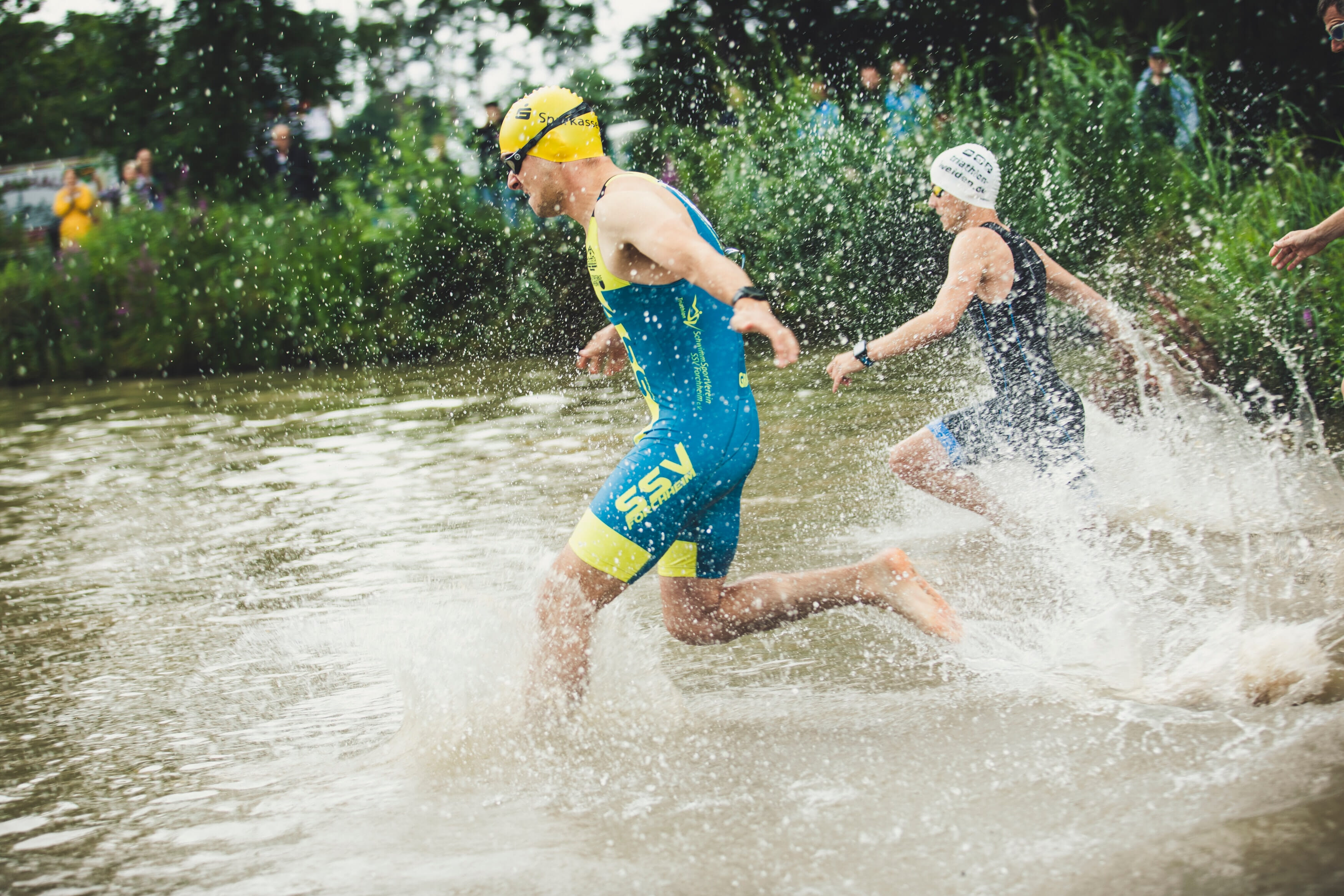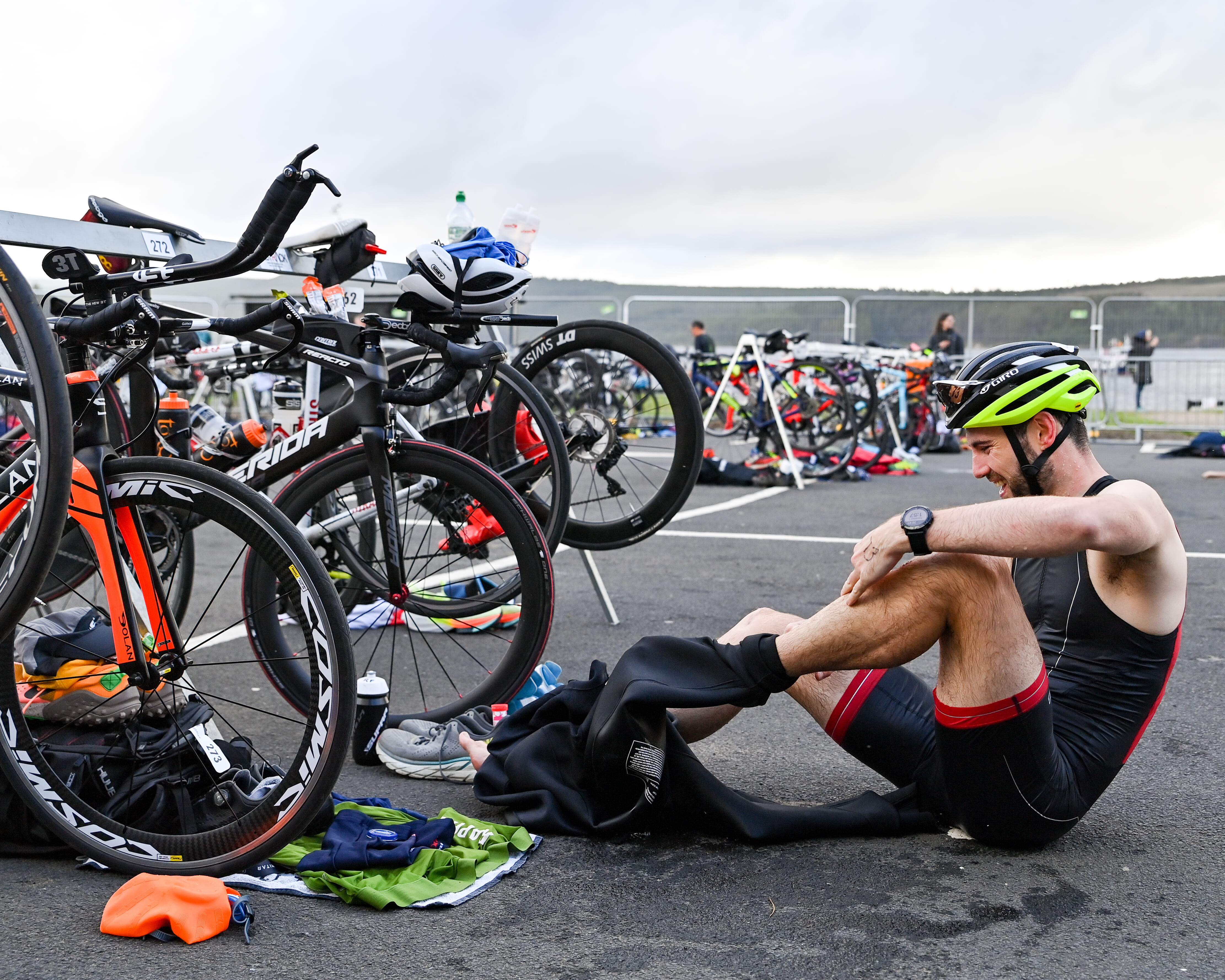Enter your first triathlon
This dynamic multi-sport will test your speed and stamina across three different disciplines, providing an incredible experience along the way! For first-time triathletes, we've gathered together everything you need to know about completing your first swim-bike-run into one place: right here.

Triathlons are among the most iconic endurance sports, with their dynamic combination of swimming, cycling and running showcasing the ultimate test of stamina. Whether it's a local sprint distance triathlon, off-road ultra or a classic overseas Ironman event, swim-bike-runs pit triathletes against both the elements and themselves like no other event type.
Getting started as a beginner triathlete can feel daunting but the rewards far outweight any initial trepidation about taking the plunge! With a basic understanding of how triathlons work, the essential kit you can't compete without and some core training advice, anyone can enter a novice triathlon and have an incredible experience. This guide covers all of those essentials and suggests some great beginner triathlons to kickstart your swim-bike-run experience.
A beginner's guide to triathlon
Let's start at the very beginning. In the vast majority of cases, triathlons follow a strict format: a swimming section, a cycling section and a running section, with two transitions between. This is a continuous race and there are different rules to follow in each of these sections and the transitions have their own stringent rules, where breaking them will result in a time penalty. Some triathlons switch up the format, like the Roc series of ultra triathlons, which have two cycling sections and a final, short sprint to the finish line. Overwhelmingly, though, a triathlon is a swim-bike-run.
Despite their modern popularity, triathlons haven't been around all that long. The 2000 Olympic Games in Sydney were the first time the sport had featured in that competition, just 26 years after the first recorded triathlon in 1974, organised by the San Diego Track Club. These days, you can find a wide range of triathlons across the UK and the world, including solo and team events, as well as road and off-road versions.
Triathlon distances
Some of the most famous triathlons are the Ironman events, famous for being an ultra endurance race that can take over 12 hours to complete. Other events go even further, priding themselves on being as tough as possible, like the aptly named Brutal Extreme Triathlon in Wales or the infamous Norseman held in the icy fjords of Norway.
These events are fantastic experiences but, thankfully, there are plenty of triathlons at the less extreme end of the spectrum. Events usually fall into one of the following categories:
Novice triathlons: These don't have a set distance but are created with beginner triathletes in mind, so usually won't include much more than a 200m swim, 15K cycle and 2.5K run.
Super sprint triathlons: Another great option for beginners, these events will cover a similar distance and may be entered by more experienced triathletes looking to test their speed.
Sprint triathlons: These fast races feature a 750m swim, 20K cycle and 5K run and are ideal for triathletes transitioning from beginner races to more established events.
Olympic triathlons: As it says on the tin, these races copy the format of triathlons in the Olympic Games: a 1.5K swim, 40K bike ride and a 10K run. While professionals will complete this in under two hours, amateur triathletes will be looking closer to three hours.
70.3 triathlons: These races are half the Ironman distance, otherwise known as 70.3 events as they clock up a total of 70.3 miles. That includes a 1.2-mile swim (1.9K), 56-mile bike ride (90K) and a half marathon, or 13.1-mile run (21K).
Ironman triathlons: Although Ironman is an official brand and race organiser of triathlons, the distance they use has been adopted as a standardised 'full' distance triathlon, which is 2.4 miles (3.9K) in the water, 112 miles (180K) on the bike and a full marathon to finish, or 26 miles (42K).

Signing up for your first triathlon doesn't have to mean jumping in at the deep end!
What about transitions?
Transitions mark the end of one section and the beginning of another, so in most triathlons you'll end up with two: T1, moving from the swim to bike, and T2, moving from the bike to run. As the clock is ticking throughout the whole race, you'll need to move through transition as quickly as possible while following the rules to avoid a time penalty.
Some events will introduce their own variation on the rules but most will follow those set out by British Triathlon:
Helmets must be worn before you pick up your bike in T1 and until you've re-racked it in T2.
Bikes cannot be ridden in transition and must be wheeled to the mount line on exiting T1 and from the mount line in T2.
All equipment must be tidily stored in a box by your allocated transition area to avoid impacting other competitors.
No outside assistance from spectators or coaches is allowed during T1 or T2.
There are some additional rules but that covers the main issues that people often encounter in transition. When you're cold and tired after swimming, it can be easy to forget to fasten your helmet strap before leaving your station, but doing so could cost you a time penalty so take care!
Road vs trail
As triathlons have exploded across the UK, race organisers have experimented with the format to create new and exciting event types, including the option to race on tarmac or on trails, or even a mix of the two, like the Northumbrian in Kielder Forest. Your decision over which to go for will largely depend on what kit you have - for someone with a road bike, entering a completely off-road triathlon will mean buying a new set of wheels! While this might be a good excuse to invest in new kit, for your first triathlon it's far more convenient to pick whichever terrain works for your current equipment.

Preparing for your first triathlon means being specific in your training.
How to train for your first triathlon
Right, you've got three disciplines to train for and you need to be good at all of them - where do you start? Thankfully, the reality of preparing for your first triathlon is usually less daunting than that sounds. Most people will transition to triathlons from being a runner, cyclist or swimmer, which will give you a good endurance base from which to adapt and specialise. From there, you need to set yourself a training goal, identify your weaknesses and start stacking your sessions together.
What's your goal?
We're sorry to be the bearers of bad news but in your first ever triathlon, you're not going to become the new Alistair Brownlee or Lucy Charles-Barclay. Depending on which event you pick, though, you may want to target more than just getting over the finish line in one piece! Setting an achievable goal is an essential part of planning your training for the event as it will give you a focus. Targeting to finish a novice triathlon in under an hour, for example, is an achievable goal that will help you to plan your approach to your training, as well as giving you a clear focus on the day of the race.
Target your weakness
Pretty much all triathletes will have one discipline they love, one they don't like and one they just coast through. For many, swimming is the section that people struggle with and look forward to the least but it could be any of the three (when our Editor's bike broke on his debut 70.3 triathlon, the cycling was definitely the worst section). When planning your training, don't avoid the discipline you least gravitate to - target it specifically and try to make it a strength.
If you are a strong runner, average cyclist and poor swimmer, despite needing to train all three you should put more emphasis on your swimming. So if, for example, your schedule allows for four training sessions per week, get in the pool for two of those and dedicate one each to the other disciplines. This approach should help to give your training some direction and purpose, alongside your event goal.
Practise transitions
You need to get used to transitions for two key reasons. First, the rules mentioned above are tightly observed and making a mistake could cost you a time penalty, so it's well worth practising them in race conditions. Secondly, your training needs to include brick sessions, where you stack two disciplines together into one session. In most cases, this will mean heading out on your bike before practising T2 into your run. If you have a friend or family member to help out, get them to mark out a mount line that you need to dismount in front of and walk your bike to its rack. Simulating race conditions will help you to become familiar with them.
If you have access to an outdoor pool, it would be a great advantage to practise T1 from swimming into cycling, too. This will probably mean having someone else on hand to help but it's relatively common practise to set up a transition station at the boot of your car for T1.
Brick sessions will feel very unfamiliar when you first do them, particularly a T2 transition - moving from cycling to running will give "jelly legs" to even experienced triathletes! These sessions are invaluable for your preparation, though, and mean that your first triathlon won't be a completely alien experience.

Don't be overwhelmed by the equipment on display at transition!
Kit list for beginner triathlons
Getting the right clothing and equipment can often be one of the biggest barriers to people getting started in triathlon in the first place, particularly when you see experienced athletes with carbon fibre bikes, aero helmets and high performance wetsuits. The truth is you can spend an absurd amount of money on triathlon kit if you want to - for professional athletes, having the right equipment in their armoury can be the marginal gains needed to get a win. If you're just getting started in triathlon, though, there is absolutely no need to.
Most novice triathlon events will take place on courses that are accessible and in seasons that do not demand additional kit, so you can make do with a basic level of clothing and equipment. There are certain things that you clearly cannot race without but all the bells and whistles can wait until you've decided to invest in triathlons more seriously. For a round-up of beginner triathlon kit, read on.
Beginner triathlon kit: bike
A bike will be your biggest expense as a budding triathlete, there's just no getting around that. That doesn't mean that you have to spend thousands on a pair of wheels just to get involved, though. For your first triathlon, you just need something that will get you round that section of the course, which is likely to be no more than 10 miles. If you already own a bicycle, there's a good chance it will be good enough to get you between T1 and T2.
Of course, your decision here will be partly dependant on the goals we mentioned earlier. If your goal is to complete a triathlon and enjoy the experience, an imperfect bike - potentially borrowed if you don't own one - will be good enough. If, however, you are hoping to finish within a certain time, you may wish to purchase a better bike and, crucially, get it fitted to your measurements, which is one of the most important steps you can take to cycling more efficiently.
If you are going to buy a bike, don't worry about getting something that weighs less than a baby bird and is packing more carbon fibre than Iron Man. Unless you're planning to move on and race, you'll be better off with a sportive bike than the low profile of a race one - they promote a more relaxed, upright position that's comfier to ride in. From there, you can move on to make more personalised decisions about disc brakes, frame material, and much more.
Beginner triathlon kit: trisuit
Trisuits are a great investment if you can afford it - they are worn underneath your wetsuit during the swim, for warm weather events, are all you'll wear for the cycling and running sections. Essentially, they are one-piece suit covering your arms, torso and legs, providing padding for the cycle and a high-performance material that wicks sweat away, keeping you cool.
If you don't have a trisuit, it's not a problem - you're perfectly able to race in regular cycling shorts and a t-shirt. We would definitely recommend padded shorts for the bike leg or the running section will be much more uncomfortable!

Trisuits help to make transition in T1 much faster.
Beginner triathlon kit: wetsuit
British Triathlon advise that all novice triathletes wear a wetsuit and they are mandatory for any event where the water temperature is under 14°C (for distances under 1500m, which a beginner triathlon will be). Luckily, wetsuits are much less expensive than bikes, so despite being a mandatory investment it shouldn't set you back too much.
The key consideration to make when making this purchase is to avoid a surfing wetsuit in favour of a swimming one. While surfing wetsuits prioritise insulation, swimming ones are lighter and favour greater mobility around the shoulders and hips to help you swim - after all, you'll warm up once you get moving! Beyond that, the most important factor is how well the wetsuit fits you rather than what materials it's made out of or the presence of any other performance factors.
Beginner triathlon kit: running shoes
If you're already wearing a trisuit, the only change you'll need to make in T2 is into your running shoes. For off-road events, you can read our complete guide to trail running shoes; for road races, the only real key is to make sure that your shoes fit you properly. That sounds overly simplistic but far too many runners get hung up on the optimal heel-to-toe drop and cushioning material, forgetting that going for a gait analysis to get shoes fitted to your individual feet is the most important consideration you can make.
Best triathlons for beginners
With an achievable goal in mind, a training programme optimised to address your weaknesses and the right kit in your corner, the final step is to find a triathlon that you want to enter! While there's nothing to stop you jumping into a sprint or Olympic triathlon first time, we'd really recommend signing up for a novice or super sprint event first. It will help you to understand the transitions in much more detail and will give you experience of completing each leg in race conditions. These events are some of the best beginner triathlons in the UK!